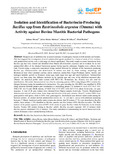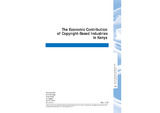Journal Articles: Recent submissions
Now showing items 881-900 of 1026
-
Magnetic Concentration of Iron in Lateritic Soils from Kamahuha, Murang’a County, in Kenya using Carbon Monoxide Generated In-Situ
(2014)Chemical and Mineral Analyses of laterites from selected sites in Kamahuha area of Murang’a County, in the Republic of Kenya, have been carried out with particular interest in the levels of iron and the type of minerals ... -
Beneficiation of Iron in Thermal-Reduced Ilmenite by Magnetic Separation
(2013)Increasing demands for Iron in countries development, and lack of conventional reducing agents has resulted into sourcing of alternative ways of beneficiating the iron ore. This paper reports on the study that was done to ... -
IJSET@2014 Page 707 Effects of Temperature on Ilmenite During Concentration of Iron in Laterites Using Charcoal and Separation using Magnetic Separation
(2014)Effect of temperature on ilmenite minerals found in laterites has been investigated. It was found that during reduction of iron minerals in laterites to magnetite using charcoal at temperatures of about 500-700oC, ilmenite ... -
Isolation and Identification of Bacteriocin-Producing Bacillus spp from Rastrineobola argentea (Omena) with Activity against Bovine Mastitis Bacterial Pathogens
(2015)Bacteriocins offer an advantage over antibiotics in that they target very specific organisms and they are generally regarded as safe for humans. The aim of this study wasto isolate and identify bacteriocin-producing Bacillus ... -
Inhibition Of Bovine Mastitis Pathogens By Bacteriocins Produced By Bacillus Spp Isolated From Rastrineobola Argentea (Omena)
(2015)Bacteriocins offer an advantage over antibiotics in that they target very specific organisms and they are generally regarded as safe for humans. The aim of this study was to isolate and identify bacteriocin-producing ... -
UNDERSTANDING THE TRAVEL MOTIVATION AMONG YOUTH TRAVELERS IN KENYA: THE ‘PUSH’ AND ‘PULL’ PARADIGM
(2010)This study explores the factors that motivate youth travel in Kenya using the ‘Push’ and ‘Pull’ theory. This questionnaire survey involved 132 respondents aged between 15 and 32 years drawn from visitors to Nairobi National ... -
Interrogating alkyl and arylalkylpolyamino (bis)urea and (bis)thiourea isosteres as potent antimalarial chemotypes against multiple lifecycle forms of Plasmodium falciparum parasites.
(2015)Abstract A new series of potent potent aryl/alkylated (bis)urea- and (bis)thiourea polyamine analogues were synthesized and evaluated in vitro for their antiplasmodial activity. Altering the carbon backbone and terminal ... -
Antiplasmodial flavonoids from Erythrina sacleuxii.
(2005)Abstract The acetone extracts of the root bark and stem bark of Erythrina sacleuxii showed antiplasmodial activities against the chloroquine-sensitive (D6) and chloroquine-resistant (W2) strains of Plasmodium falciparum. ... -
Antiplasmodial activity, in vivo pharmacokinetics and anti-malarial efficacy evaluation of hydroxypyridinone..
(2015)Background: During the erythrocytic stage in humans, malaria parasites digest haemoglobin of the host cell, and the toxic haem moiety crystallizes into haemozoin. Chloroquine acts by forming toxic complexes with haem ... -
The link between seasonal climatic variability and poverty: A case study of pastoral and agro-pastoral communities in Baringo District, Kenya
(2010)Poverty remains rampant in the dry districts of Kenya so that it has now become an important item on Kenya’s development agenda. The dry districts of Kenya receive low amounts of rainfall, which is also erratic. These ... -
The impact of climate variability and extreme weather events on gender: Gender vulnerabilities and adaptation strategies for improved household food security in Malawi
(2009)The challenge to achieving household food security is a combination of biological, physical, and social factors. However, social factors, gender in particular, have received a cursory attention in adaptation studies. ... -
The Economic Contribution of Copyright-Based Industries in Kenya
(2009)The overall objective of the Kenyan study was to quantify the economic contribution of copyright and related rights-based industries in the country by estimating their value-added to GDP, share of national employment, and ... -
The Desert Margins Programme Approaches in Upscaling Best-Bet Technologies in Arid and Semi-arid Lands in Kenya
(2011)Kenya’s land surface is primarily arid and AQ1 semi-aridlands(ASALs)whichaccountfor84%ofthe totallandarea.TheDesertMarginsProgramme(DMP) inKenyahasmadesomecontributiontounderstanding which technology options have potential ... -
The choice of grass species to combat desertification in semi-arid Kenyan rangelands is greatly influenced by their forage value for livestock
(2013)Livestock production is the main source of livelihood in the arid and semi-arid lands in Africa. However, desertification characterized by vegetation degradation and soil erosion is a major threat to the sustainability of ... -
The challenges of rehabilitating denuded patches of a semi-arid environment in Kenya
(2010)Land degradation is a major problem in the semi-arid environments of Sub-Saharan Africa. Fighting land degradation is essential to ensure the sustainable and long-term productivity of the habited semiarid lands. In Kenya, ... -
Livestock as Capital and a Tao I for Ex-Ante and Ex-Post Management of Food Insecurity in Semi-traditional agro-pastoral societies:an example from South East Kenya
(1999)Discussions of the roles of livestock in many societies is not something new. They have been done in anthropological, sociological and, to some extent, economic literature. However, most of these discussions are normally ... -
Levels and causes of household food and nutrition insecurity in dryland Kenya
(2002)Ensuring food and nutrition security in the drylands of sub-Saharan Africa is a critical challenge. Often, information on the level of insecurity is either scanty or unavailable. This paper looks at food and nutrition ... -
Land-Use Change and Livestock Production Challenges in an Integrated System: The Masai-Mara Ecosystem, Kenya
(2009)Participatory rural appraisal techniques and a survey of 100 households were used to evaluate livestock production, and pastoral development of the Maasai in Mara. It was observed that patterns of land-use have principally ...




















